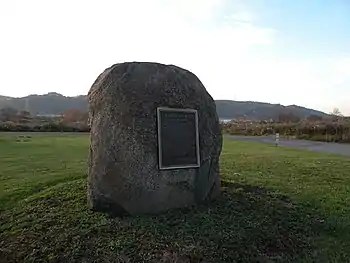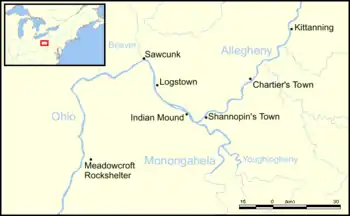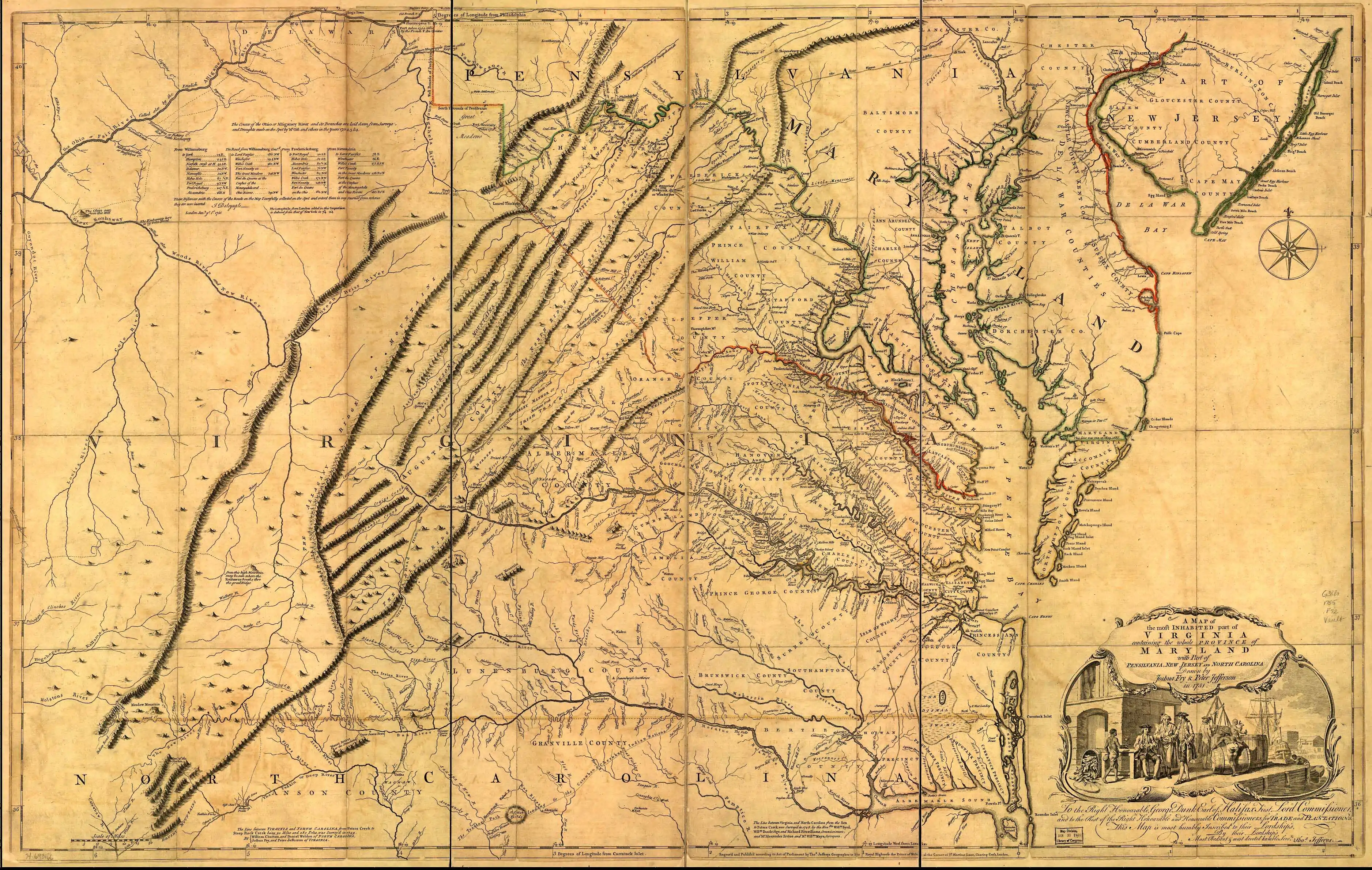Logstown
The riverside village of Logstown (1725?, 1727–1758, also Logg's Town, French: Chiningue pronounced Shenango), near modern-day Baden, Pennsylvania, was a significant Native American settlement in Western Pennsylvania, and the site of the 1752 signing of the treaty of friendship between the Ohio Company and the First Nations occupying the region in the years leading up to the French and Indian War—during which Logstown became nearly depopulated and abandoned. Being an unusually large settlement, and because of its strategic location, Logstown was an important factor of all parties developing the Ohio and tributary rivers.



Logstown is located in Harmony Township, northwest of the Forks of the Ohio (now in downtown Pittsburgh) in an area on the east bank of the Ohio River opposite Aliquippa. The site is also due north of the Pittsburgh International Airport.
History
Located directly on the right bank of the Ohio River, the original village was settled by Shawnees, possibly as early as 1725, on low-lying land on the north bank of the Ohio, less than a mile north of present-day Ambridge in Beaver County, Pennsylvania.[1] In the rich soil by the riverside, the Shawnees cultivated maize. In 1744 the town's population increased significantly when Kakowatchiky arrived with his band of 200 Shawnee warriors and their families from Wyoming, Pennsylvania.[2]
As part of their effort to claim the Ohio Valley, around 1747 the French built about 30 log cabins, some with stone chimneys, on a plateau above the original Logstown village.[1] The French turned over these cabins to the Natives. Only 18 miles downriver from present-day Pittsburgh, Logstown predated the French fort at Pittsburgh, Fort Duquesne, by at least seven years. Logstown therefore became an important trade and council site for both the French and the Natives, and ironically, the British also.
In 1747, the Six Nations Confederacy Haudenosaunee sent two headmen: Tanacharison, a Seneca, and Scarouady, an Oneida, as emissaries to live in Logstown. Tanacharison sided with the British in the coming war.[3]
In 1748, the colony of Pennsylvania sent Conrad Weiser, Pennsylvania's ambassador to the Six Nations, to Logstown. He held council with a gathering of chiefs, who complied with his request for a count of their warriors in the Ohio Valley region:[1]
- Iroquois, or Six Nations:
- Allies of Iroquois:
- Wyandots: 100
- Others:
- Shawnees: 162
- Tisagechroamis: 40
- Mohicans: 15
- Lenape (Delaware): 165
- Total : 789
In 1749, the French marked their claim of the watersheds of the Allegheny River and the Ohio River. The governor of New France sent a force of 300 men, led by Céloron de Blainville, down the Allegheny and Ohio. Along the way, Céloron nailed copper plates bearing royal arms to trees, and buried inscribed leaden plates at the mouths of principal tributaries. When Céloron arrived at Logstown, he discovered some British traders there. Incensed, he evicted the traders and wrote a scolding note to the governor of Pennsylvania.[4] He then browbeat the Natives about French dominance of the region. The expulsion of the British traders and the browbeating offended the Iroquois, some of whom returned to their homeland, tearing down the French copper plates as they went.
On May 28, 1752, the British held a council at Logstown with representatives of the Six Nations, and the Lenape and Shawnee who had been tributary to them. Colonel Joshua Fry and two other commissioners represented the colony of Virginia, and Christopher Gist represented the Ohio Company.[1] The Iroquois "half-King" or sachem, Tanacharison, declared that his people did not consider that the 1744 Anglo-Iroquois Treaty of Lancaster had ceded the colonists any land beyond the Allegheny Mountains, but he promised the Iroquois would not molest any British settlements southeast of the Ohio River. He also formally requested that a British fort be built at the mouth of the Monongahela River, the site of present-day Pittsburgh. This fort, Fort Prince George, was still in construction in January 1754 when it was razed by a much larger French force, which then built Fort Duquesne in the same spot.
In late 1753, Virginia Governor Dinwiddie sent an eight-man mission headed by a young (21) George Washington to warn the French away from the Ohio Valley, and assert the claim of the Ohio Company. From November 24 to 30, Washington held council with Tanacharison and Scarouady at Logstown. Returning to Virginia, Washington was made major and second-in-command of the Virginia Regiment, whilst Captain William Trent was sent with about 40 men along the Nemacolin Trail to the Monongahela River crossing ford at Redstone Old Forts—the earliest point at which a freight wagon road could reach the Ohio River basin—for the Virginian plan was to seal control of the area by cutting and widening the trail from the Potomac River to build a blockhouse (later called Fort Hangard) they stocked with advanced supplies on the shore at Redstone Creek.
On May 28, 1754, in Battle of Jumonville Glen, Tanacharison killed Ensign Joseph Coulon de Jumonville, an act that helped to precipitate the French and Indian War(New research suggests that it was Washington himself who fired the shot that killed Jumonville.[5]) . Following Washington's surrender at Fort Necessity, Scarouady burned down Logstown, on or about June 24, 1754. French forces under Louis Coulon de Villiers rebuilt the village.[1]
In 1754, New France built Fort Presque Isle on Lake Erie, Fort Le Boeuf on French Creek, Pennsylvania, Fort Machault near the junction of French Creek with the Allegheny River, and finally Fort Duquesne, at the forks of the Ohio.
When the army of General John Forbes occupied Fort Duquesne on November 24, 1758, the Natives abandoned many of their neighboring villages. With the construction of Fort Pitt, Logstown lost its prominence.
When Major George Washington again visited the site of Logstown on October 21, 1770, none of the residents were Native American.
In 1792, an area on or near the settlement was taken over as a military base for the newly formed Legion of the United States. Legionville became the first basic training facility for the United States Military. The site was vacated in 1793 after the troops left to fight in the Northwest Indian War.
Sources
- "Logstown, on the Ohio : a historical sketch", Agnew, Daniel, originally published by Myers, Shinkle & Co., Pittsburgh, PA, 1894, available at Historic Pittsburgh. Weiser's census of warriors at Logstown, pg. 7.
- Paul A. W. Wallace, Indians in Pennsylvania, DIANE Publishing Inc., 2007, p. 127. ISBN 1422314936
- "The Indian Wars of Pennsylvania," Sipe, C. Hale, 1931, fourth reprint, 1999, Wennawoods Publishing.
- "History of Washington County, Pennsylvania," Crumrine, Boyd, L.H. Everts and Co., 1882. Account of Céloron at Logstown, pg. 26.
- David Preston. "The Trigger" in SmithsonianOctober 2019. pp30 - 78.
Geospatial References
- Google Earth indicates a point 18 miles downriver from the Golden Triangle, next to a river, near Ambridge, PA, is at 40.622942, -80.226675.
- 40.622942°N 80.226675°W

